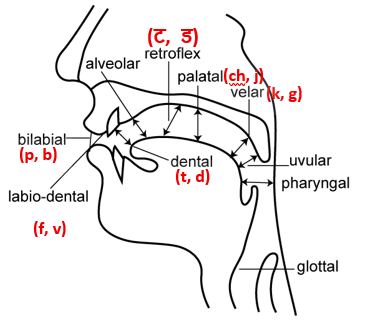The World’s First (and Only) Truly Phonemic Alphabet
ABCs OF PHONETICS AND PHONEMICS FOR THE NON-LINGUIST
Most sounds in human language that come from the vocal apparatus can be classified according to where the parts of the tongue contact parts of the throat or mouth, known as the articulation position. This can be conveniently classified starting from the very back of the throat to the front of the mouth. As shown in the Figure at right, this starts with the glottal and ends with the bilabial position.
Sounds of human language are also classified phonetically according to the following:

- Voiced sounds are when the vocal chords vibrate. So p is unvoiced and b is its corresponding voiced
- Aspirated (महाप्राण) sounds are when there is aspiration (breath), as in p (प) ph (फ).
- Fricatization is when there is a frictional or hissing or rough sound, as in shhhhh or sssssss or hhhhhhh. So the sounds s, h and f are fricatives.
- Vowels are when there is absolutely no impediment to the breath. Thus a, e, u, o and also the vocalic r-sound (ऋ), are all vowels. Everything else is then a non-vowel.
Now a phone is any sound. A phoneme is a phone (sound) with linguistic significance. What do we mean by “linguistic significance”?
Well, there’s actually a very simple test!— The test for whether a phone (sound) is a phoneme in a particular language is if substituting one phone for another in it changes the meaning of the word. Thus:
- In English, pet and bet have entirely different meanings, so the phones p and b are different phonemes in English. Because substituting one for the other completely changes the meaning of the word.
- But in Mandarin, pu and bu both mean “no/not”, and Peijing and Beijing both mean the same city, so p and b are part of (are allophones of) the same phoneme in Mandarin. Because substituting one for the other does not change the meaning of the word.
- Similarly, in English vet and wet have entirely different meanings, so the sounds v and w are different phonemes in English.
- But in Hindi, van and wan (वन) both mean “forest”, so v and w are the same phoneme in Hindi.
- A phonemic alphabet needs to be able to encode and convey this information to the reader. To the best of public knowledge, no other world alphabet does this.
So again, we ask, “Why NAVLIPI?!”. Because without encoding and conveying phonemic information, it is difficult or impossible to write, say, Mandarin and English, or Hindi and Tamil, or even for that matter Hindi and English, in the same alphabet. One would have no way of knowing the particular and unique phonemic idiosyncrasies of each of these languages!